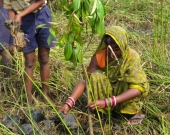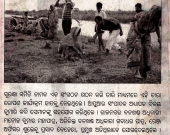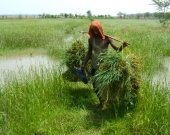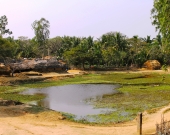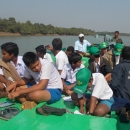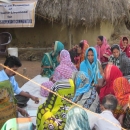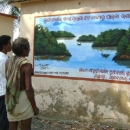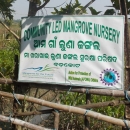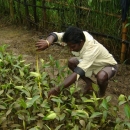Grants :: Small Grant Facilities :: Community stewardship in conservation, restoration and sustainable management of mangroves in Orissa coast
Community stewardship in conservation, restoration and sustainable management of mangroves in Orissa coast
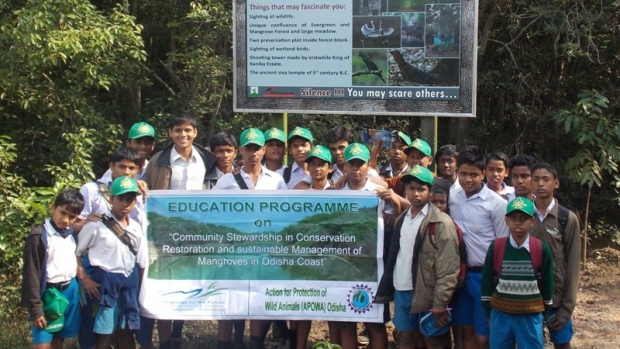
Eco-club students participate in the mangroves awareness cam ... , Rajnagar, Kendrapara, Orissa © APOWA, 2012
Objectives
The objective of the project is to strengthen and sustain community stewardship in conservation, restoration, sustainable management of mangroves based on scientific principles, taking into account the vulnerability of the region to natural disasters, sustainable livelihood security for local communities and conservation of ecologically significant natural resources
Background
The biodiversity rich Bhitarkanika mangroves of Orissa (a Ramsar site) are of immense value, providing ecological, livelihood and food security. Sustainable management and conservation of these vital and life sustaining natural resources involving local communities and other stakeholders are essential. These mangrove forests are fragile due to high deforestation and alteration of mangrove forest patches. Mangroves in many areas adjacent to Bhitarkanika have been clear felled, thus these areas are now devoid of mangroves.
The objective of the project is to strengthen and sustain community stewardship in conservation, restoration, sustainable management of mangroves based on scientific principles, taking into account the vulnerability of the region to natural disasters, sustainable livelihood security for local communities and conservation of ecologically significant natural resources
The focus of the project is to empower local communities in sustainably managing and conserving the mangrove resources in partnership with other stakeholders, making all accountable for the results of this stewardship. Village level institutions like Village Mangrove Councils (VMC) will be formed and strengthened for sustainable management and conservation of mangrove resources. The interventions are intended to result in reduction in mangrove over-use and creation of new mangrove forest, to minimize the dependency of people on mangrove forests, and to improve the skills for alternative livelihoods. Restoration of mangroves will protect of the hinterland from periodic cyclones, super cyclones and tsunami, etc., which is very common in this region. In addition, it will help in increased fish, crab population and other biodiversity as well as check soil erosion.
Target beneficiaries
- Direct beneficiaries Mangrove communities from ten project villages in the Rajnagar block of the Kendrapara district.
- Indirect beneficiaries Forest department officials (including those from Bhitarkanika national park)
Outputs
The focus of the project is to empower local communities in sustainably managing and conserving the mangrove resources in partnership with other stakeholders, making all accountable for the results of this stewardship. Village level institutions like Village Mangrove Councils (VMC) will be formed and strengthened for sustainable management and conservation of mangrove resources. The interventions are intended to result in reduction in mangrove over-use and creation of new mangrove forest, to minimize the dependency of people on mangrove forests, and to improve the skills for alternative livelihoods. Restoration of mangroves will protect of the hinterland from periodic cyclones, super cyclones and tsunami, etc., which is very common in this region. In addition, it will help in increased fish, crab population and other biodiversity as well as check soil erosion
Accomplishments and challenges
- Twelve hectares of mangroves were restored
- Village Mangrove Councils (VMCs) were formed in all ten project villages to manage the sustainable use of the forests and to ensure the longterm cosnervation of the mangroves.
- 48,000 mangrove saplings were grown in the nursery established under this project; 36,000 saplings were distributed to the VMCs and 12,000 saplings to the community for plantation
- Training in alternative and supplementary livelihoods was imparted to 981 men and women in the ten villages with the objective of reducing pressure on the mangroves.
- Ten mangrove conservation related awareness programmes were conducted for 1,035 community and VMC members. An awareness camp (including forest tours for eco-club students) were conducted for 1,178 students and teachers from eight school.
- It was observed that illeagal felling of the mangrove greatly diminished in the course of the project. As a result of controlled grazing of domestic ungulates, the land was allowed to recover providing for the abundant growth of alternative fodder sources (for livestock) like Proteresia coarctata (wild rice which forms an important constituent in the plant succession leading to formation of mangrove communities along the estuaries in India) and Avicennia twigs.
Contributions to cross-cutting themes
As the result of the abundant growth of weeds and other mangrove associates that are now being used as a source of fuel, women in the vilalges are no longer compelled to enter into the forest to collect resources for fuel; they thus have more time on their hands. An upside of this is that the introduction of vegetable cultivation as a supplmentary livelihood (as part of this SGP) has been actively taken up by women. Several women have banded together to form their own enterprise and are now selling vegetables in the local markets - helping to ease the financial burdens on their families and empowering them to take up positions in local governing institutions and on the Village Mangrove Councils.
As a reuslt of this project several education and awareness related board signs, banners, posters and brochures have been developed in English, Hindi and Odhisha. These have been placed at entery points into the Bhitarkanika mangrove forest, in the project villages and to the communities and forest officials in the region.
Lessons Learned
- The need for sustained sensitization of communities on mangroves and how it affects their livelihoods been the most critical learning from this intervention. This is only effective if institutional set-ups at the village level, like village mangrove councils, are strengthened to assume responsibility of the ecosystem, ensure it’s sustainable use and maintain transparency and equity. This also promotes a sense of pride and livelihood security.
- The increased participation of women in the project activities was a real mark of success, particularly in a culture and society where women are often seen at the forefront of decision-making activities and management. The introduction of livelihoods for the women increased their family’s financial capacity and imparted a sense of equity that prompted them to become part of the VMCs and various other local set-ups.
- It was also observed that, the closer cooperation and information & knowledge sharing between one VMC to other VMC on mangrove restoration and conservation is encouraging. Each VMC has been playing a significant role as facilitator for communication and liaison between villagers and project team for mangrove restoration and conservation. The collective action of communities building a solidarity effort and strengthens a sense of stewardship which is important for the sustainability of the community work for the mangrove resource management and conservation.
- Engaging and encouraging the local media personnel is very important as an advocacy strategy and highlight critical mangrove issues. With this in mind, the media was invited and encouraged to publish articles on the importance of mangroves, project activities and successes. (Please refer to Annex 3 for the press clippings)
- Working in cooperation and association with a variety of stakeholders including local forest department, women groups, youth clubs, NGOs, fishermen community associations, and local panchayat that have diversity of ideas, united of voices, knowledge, and experience also provides many benefits, as the stakeholders bring their own strengths in one platform.
Related News
Women in Bhitarkanika join the crusade to save mangroves!
Orissa, India 22 Mar 2013
Country: India
Topic: Knowledge for Management, Civil Society Engagement, Capacity Building ...
The Bhitarkanika mangrove sanctuary is the life force for the majority of coastal communities living in the Kendrapara district of Orissa, India. Although the sanctuary serves to protect fundamental ecosystem services and diversity, several communiti...
Strengthening Community Awareness through the Media
Kendrapara, Orissa, India 13 Mar 2013
Country: India
Topic: Knowledge for Management, Knowledge management and communications
The use of media to advance sustainable resource management and conservation in a cost effective, efficient and accessible manner is an integral component in most successful projects
Promoting sustainable feed and biofuel production in community conserved mangroves areas (Orissa, India)
Orissa, India 31 Jan 2013
Country: India
Topic: Knowledge for Management, Strategies for Management, Civil Society Engagement ...
Livestock has long been a mainstay from several coastal communities in Orissa. However, the unregulated browsing of ungulates including goats, cows and buffaloes has taken its toll on the state’s coastal grasslands, commonly associated with mangroves...
Love for Mangroves is Love for God
Orissa, India 28 Feb 2012
Country: India
Topic: Capacity Building, Community Resilence, Climate change ...
Project Facts
Country
Location
Rajnagar, Kendrapara district (Bhitarkanika mangrove forest) Orissa, India
Topic
- Knowledge for Management
- Strategies for Management
- Monitoring, Learning and Evaluation
- Civil Society Engagement
- Community Resilence
- Sustainable Livelihoods
- Capacity Building
- Gender equality
- Knowledge management and communications
Duration
20th Jan 2012 to 31st Dec 2012
MFF Grant Amount
INR 814,340
Co-financing Partner
APOWA & local communities - INR 170,100
Implementing Partner
Mr. Bijaya Kumar KabiDirector Action for the Protection of Wild Animals (APOWA)bijayakabi@apowa.org“We found it easier to make a living (growing vegetables) from our small piece on land than (entering into and)exploiting the mangrove forest. We have set example for others.” Parvati Pradhan, a 43-year-old woman, and her husband are supporting a thirteen member large family. They now grow vegetables and fruits like papayas, drumsticks, brinjals, tomatoes, okra and leafy vegetables in their own backyard where the land is fertile as a result of the healthy growth of the nearby mangrove forest. They grow enough to sustain the whole family and even sell the surplus to ease their financial burdens.
“We are happy to be engaged in the mangrove plantation, and protection work. It’s great and we are able to motivate other people in our village to participate with this project, which will not only protect our futures, but will also give livelihood support to our family”, says Mrs. Lili Priyadarshani Rout, president, Maa Mangala SHG, and member, Sidha Marichani VMC (Basantpur village)
Related Images
Related Publications

Community Stewardship in Conservation, Restoration and Sustainable Management of Mangroves in Orissa
Author: APOWA/MFF India
Publisher: APOWA
Posted on: 21st Jun 2013
Category:
Size: 2.2 MB
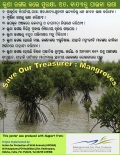
Save Our Treasure: Mangroves
Action for the Protection of Wild Animals, APOWA
Author: APOWA
Publisher: APOWA
Posted on: 12th Nov 2012
Category:
Size: 312 KB
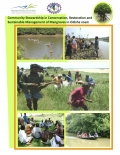
Community Stewardship in Conservation, Restoration and Sustainable Management of Mangroves in Odisha Coast
Action for the Protection of Wild Animals, APOWA
Author: APOWA
Publisher: APOWA
Posted on: 7th Aug 2012
Category:
Size: 3.3 MB
